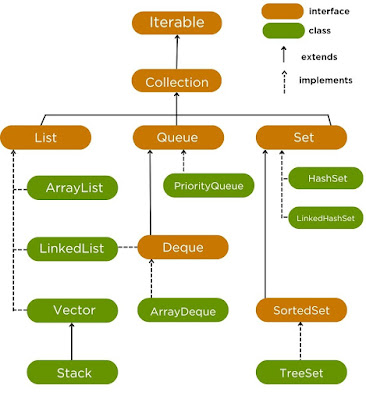Collections in Java provide a way to store and manipulate groups of objects. Think of collections as containers that allow you to efficiently manage, organize, and manipulate data.
In Java, the Collections Framework is a set of interfaces and classes that provide reusable data structures.
Collection Hierarchy:
List Interface
- Represents an ordered collection, allowing duplicate elements.
- Key implementations include ArrayList and LinkedList.
- Methods like add, remove, and get are common in List implementations.
ArrayList:
- Implements the List interface and is backed by a dynamic array.
- Provides fast random access and dynamic resizing.
- Suitable for scenarios where frequent access and modification of elements are required.
LinkedList:
- Also implements the List interface but is backed by a doubly-linked list.
- Well-suited for scenarios where frequent insertion and deletion operations are common.
- Supports sequential access and offers constant-time insertions and deletions.
Vector:
Similar to ArrayList, implements the List interface, and is synchronized.
Suitable when thread safety is essential but might incur performance overhead.
Stack:
A subclass of Vector, implements the List interface with additional methods.
Follows the Last In, First Out (LIFO) principle, commonly used in undo mechanisms.
Set Interface
- Represents an unordered collection with no duplicate elements.
- Key implementations include HashSet and TreeSet.
- Useful when uniqueness and absence of order are essential.
HashSet:
- Implements the Set interface and uses a hash table for storage.
- Provides constant-time performance for basic operations like add, remove, and contains.
- Does not guarantee order.
LinkedHashSet:
Extends HashSet, preserving insertion order.
Ideal when the order of elements needs to be maintained.
TreeSet:
- Also implements the Set interface but maintains elements in sorted order.
- Utilizes a red-black tree data structure for storage.
- Useful when a sorted set of elements is required.
Queue Interface
- Extends Collection and represents a collection designed for holding elements prior to processing.
- Key implementations include LinkedList and PriorityQueue.
- Supports operations like enqueue and dequeue.
PriorityQueue:
- Implements the Queue interface and represents a priority queue.
- Elements are ordered based on their natural ordering or a provided comparator.
- Useful in scenarios where elements need to be processed based on priority.
Deque Interface:
Represents a double-ended queue, allowing insertion and removal from both ends.
Implementations include ArrayDeque and LinkedList.
Useful for scenarios requiring versatile insertion and removal operations.
ArrayDeque:
Implements the Deque interface, a resizable array-based double-ended queue.
Efficient for adding or removing elements from both ends.
Map Hierarchy:
Map Interface
Remember, the Map interface in Java is not directly a part of the collection hierarchy; instead, it is a separate interface that extends the java.util.Collection interface indirectly.
- Represents a collection of key-value pairs.
- Key implementations include HashMap and TreeMap.
- Allows mapping unique keys to values, facilitating efficient data retrieval.
HashMap:
- Implements the Map interface and uses hash table for storage.
- Provides constant-time performance for basic operations on average.
- Allows null values and one null key.
LinkedHashMap:
Extends HashMap, preserving the order of key insertion.
Useful when iterating over entries requires a predictable order.
TreeMap:
- Also implements the Map interface but maintains key-value pairs in sorted order.
- Utilizes a red-black tree for storage.
- Suitable when a sorted map based on the natural order of keys is required.



No comments:
Post a Comment
Share your thoughts or ask questions below!...👇